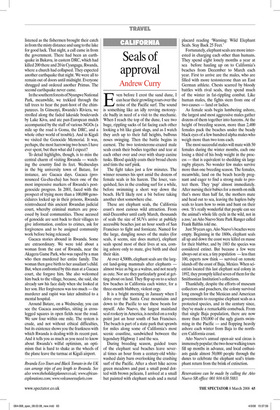Seals of approval
Andrew Curry
Even before I crest the sand dune, I can hear their growling roars over the noise of the Pacific surf. The sound is something like an idly revving motorcycle badly in need of a visit to the mechanic. When I reach the top of the dune, I see two huge, rippling sacks of fat facing each other looking a bit like giant slugs, and as I watch they arch up to their full heights, bulbous noses swinging. Then the battle begins in earnest. The two testosterone-crazed male seals crash their bodies together and tear at each other over and over with sharp canine tusks. Blood quickly coats their broad chests and tints the surf pink.
The fight takes just a few minutes. The winner resumes his spot amid the dozens of female seals in his harem. The loser, vanquished, lies in the crashing surf for a while, before swimming a short way down the beach. He’ll likely rest a bit before taking another shot somewhere else.
These are elephant seals, the California coast’s most curious wild attraction. From mid-December until early March, thousands of seals the size of SUVs arrive at publicly accessible beaches just an hour south of San Francisco to fight and fornicate. Named for the large, dangling noses of the males (for seals, it seems, size does matter), elephant seals spend most of their lives at sea, coming ashore only to mate, give birth and shed their skin.
At over 4,500lb, elephant seals are the largest land-going mammals after elephants — almost twice as big as a walrus, and not nearly as cute. Nor are they particularly good at getting about on land. They flop up on to a select few beaches in California each winter, for a three-month blubbery, violent orgy.
It is a bright morning in January when I drive over the Santa Cruz mountains and down to the Pacific to see these beasts for myself. Aflo Nuevo, the largest mainland seal rookery in America, is nestled on a rocky point just an hour south of San Francisco. The beach is part of a state park that sprawls for miles along some of California’s most scenic coastline, sandwiched between the legendary Highway 1 and the sea.
During breeding season, guided tours of the elephant seal beaches leave several times an hour from a century-old whitewashed dairy barn overlooking the crashing surf of the Pacific. After a short hike across green meadows and past a small pond dotted with brown pelicans, I arrived at a small hut painted with elephant seals and a metal placard reading ‘Warning: Wild Elephant Seals. Stay Back 25 Feet.’ Fortunately, elephant seals are more interested in charging each other than humans. They spend eight lonely months a year at sea before hauling up on to California’s beaches from December to March each year. First to arrive are the males, who are filled with more testosterone than an East German athlete. Chests scarred by bloody battles with rival seals, they spend much of the winter in fat-rippling combat. Like human males, the fights stem from one of two causes — land or ladies.
As female seals begin lumbering ashore, the largest and most aggressive males gather dozens of them together into harems. At the height of breeding season, more than 2,400 females pack the beaches under the beady black eyes of a few hundred alpha males who weigh more than two tons each.
The most successful males will mate with 50 females during the winter months, each one losing a third of his body weight in the process — that is equivalent to shedding six large rugby players. No wonder few males survive more than one breeding season. The females, meanwhile, land on the beach heavily pregnant and eager to find a strong male to protect them. They ‘pup’ almost immediately. After nursing their babies for a month on milk that’s more than half fat, the mothers mate and head out to sea, leaving the hapless baby seals to learn how to swim and hunt on their own. ‘It’s really wonderful that people can see the animal’s whole life cycle in the wild, not in a zoo,’ an Aflo Nuevo State Park Ranger called Frank Balthis told me.
Just 50 years ago, Aflo Nuevo’s beaches were empty. Beginning in the 1800s, elephant seals all up and down the coast were killed en masse for their blubber, and by 1883 the species was considered extinct. But because a few were always out at sea, a tiny population — less than 100, experts now think — survived on remote islands off the coast of Baja, Mexico. When scientists located this last elephant seal colony in 1892, they promptly killed seven of them for the Smithsonian Institution’s collections.
Thankfully, despite the efforts of museum collectors and poachers, the colony survived long enough for the Mexican and American governments to recognise elephant seals as a protected species, and in the century since, they’ve made a remarkable comeback. From that single Baja population, there are now more than 150,000 of the ugly giants swimming in the Pacific — and flopping heavily ashore each winter from Baja to the northern California coast.
Aflo Nuevo’s annual open-air seal circus is immensely popular; the two-hour walking tours fill up months in advance, and local enthusiasts guide almost 50,000 people through the dunes to celebrate the elephant seal’s triumphant return from the brink of extinction.
Reservations can be made by calling the Año Nuevo SR office: 001 916 638 5883.


















































































 Previous page
Previous page